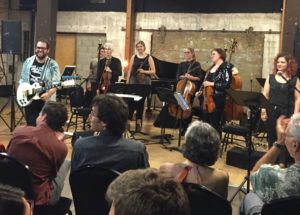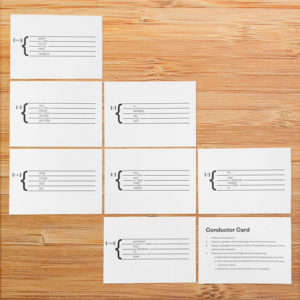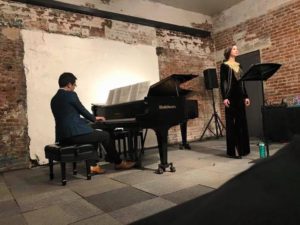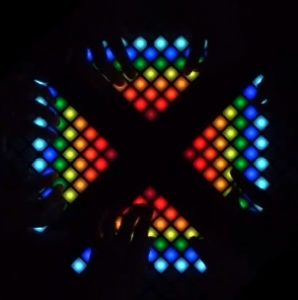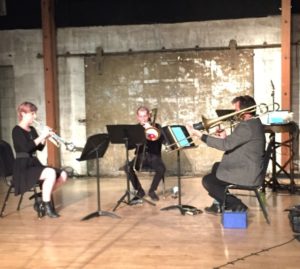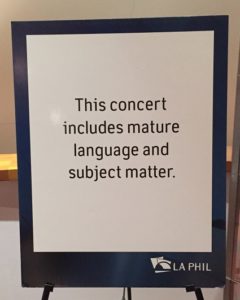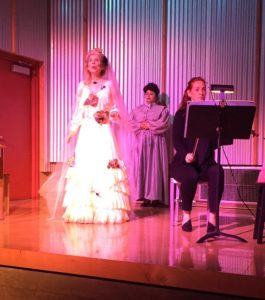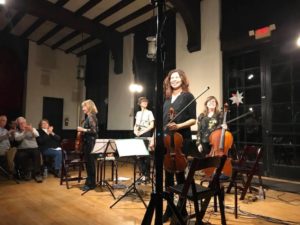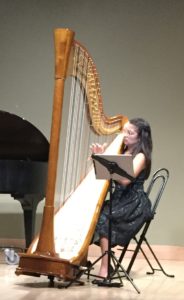 Cold Blue Music presented an evening of solos as the latest in the Soundwaves series of new music concerts held at the Santa Monica Public Library. Music by Daniel Lentz and Michael Byron was performed, with the composers in attendance. Pianist Vicki Ray and harpist Tasha Smith Godínez were on hand as soloists along with a nice crowd arriving on a perfect spring evening.
Cold Blue Music presented an evening of solos as the latest in the Soundwaves series of new music concerts held at the Santa Monica Public Library. Music by Daniel Lentz and Michael Byron was performed, with the composers in attendance. Pianist Vicki Ray and harpist Tasha Smith Godínez were on hand as soloists along with a nice crowd arriving on a perfect spring evening.
River of 1,000 Streams (2016) by Daniel Lentz was first up, featuring Ms. Ray at the piano and accompanied by a prerecorded track of fragments of the piece that were played through two large speakers on the stage. Ms. Ray wore an earbud that provided synchronization cues during the performance. River of 1,000 Streams began with thick tremolos played in the lowest register of the piano, joined by a deep tremolo rumble issuing from the speakers. The composer is quoted in the program notes stating that this piece was “conceived one early morning on the banks of the Yellowstone River.” Accordingly, there is a strong, flowing feel, surging and swelling like a powerful force of nature. The sounds coming from the speakers consisted of up to eleven different layers, weaving in and out of the texture. These were nicely complimented by the piano, and the overall result was a dark, roiling tide of sound, constantly in motion.
Although seemingly simple in structure and consistently dense, River of 1,000 Streams continuously evolved over the course of the performance. The repeating patterns moved slowly up the piano keyboard, with each new set of pitches adding to the feeling of burgeoning motion. The dynamics rose and fell, adding to the sense of immense movement. As the pitches climbed up to the middle registers of the piano, the electronics often issued strongly contrasting waves of lower tones, maintaining the sense of depth and power. The continuous playing of the tremolos, the coordination with the recorded track and the shaping of the dynamics were all expertly executed by Ms. Ray, fully engaging the audience throughout the entire performance.
As the piece reached into the upper registers of the piano, the feeling turned decidedly optimistic, even as the speakers poured out their forceful streams of sound. Every so often, a series of three or four non-tremolo chords in the piano added some drama. The optimism ultimately turned to awe and finally transcendence as the higher notes on the keyboard were heard. The piece closed on a deep rumble in the speakers, offset by long trill on the highest piano notes, neatly summarizing the entire journey. River of 1,000 Streams is a monumental work, as deeply powerful as the river that inspired it.
The second solo of the evening was In the Village of Hope (2013), by Michael Byron. This was performed by Tasha Smith Godínez who had arrived with an impressively beautiful harp that dominated the right side of the stage. The composer writes: “In the Village of Hope is a piece of unabashed virtuosity. Its complex temporal structure and intricate counterpoint vie for the listener’s attention. Pitch resources are limited to diatonic collections, enabling harmonic relationships to seamlessly cycle through seven contiguous key changes.”
This work is roughly analogous to the Lentz piece in that the texture is fairly consistent. However, In the Village of Hope is much lighter and has a more gentle feel. The copious notes pouring from the harp felt like raindrops falling on the leaves of a deep forest. Full of motion, yet always restful and serene, this piece evokes a distinctly exotic sensibility. The several key changes were very effective and provided a sense of renewal to the listener’s ear as the piece progressed. Ms. Godínez might have been expected to be quickly exhausted by the complexity and quantity of notes, but her hands were a model of economy in movement. The playing was impressively expressive and the acoustics of the space did not detract from the delicate texture of this piece. In the Village of Hope coasted to an elegant conclusion, providing another transcendent experience of the evening.
River of 1,000 Streams and In the Village of Hope are both available on CD from Cold Blue Music.
